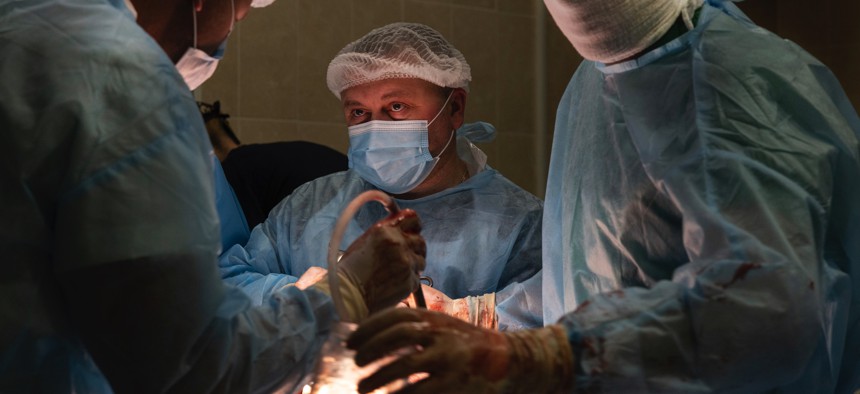
Vascular surgeon Dr. Dmytro, left, works with surgeon Dr. Vitaliy and Dr. Mykola on a patient with abdominal injuries in a hospital where military are treated on October 7, 2022, in Donetsk District, Ukraine. Paula Bronstein/Getty Images
US Medics Must Learn from Ukraine’s Harsher War, Report Says
Russia’s artillery and jammers make battlefield medicine harder and more dangerous than in Afghanistan and Iraq.
Dima, a Ukrainian mortician-turned-medic, knows all too well how dangerous medical evacuations can be. Speaking to Defense One near Kherson last November, he described how Russian tanks once fired on his ambulance, sending shrapnel through its thin sides.
Dima’s experience is far from unusual, according to a new report that describes the experience of frontline Ukrainian special forces surgeons. Published in the Journal of the American College of Surgeons, it says the U.S. should get ready for wars defined by artillery, not the homemade bombs seen in Afghanistan.
“If you look at what the next war is gonna be, every incident is going to be a mass-casualty incident,” Aaron Epstein, a doctor and president of the group that produced the report, said in an interview.
The U.S. military’s medical community needs to figure out, among other things, how to treat casualties amid ever-more-accurate artillery strikes, how to deal with electronic jamming, and how to ward off attacks on medical vehicles, the report said.
The organization behind the report, Global Surgical and Medical Support Group, has worked in Ukraine since the beginning of the war, training Ukrainian soldiers and providing medical support. It is primarily staffed by former U.S. military medical personnel, including many former U.S. special operations forces combat medics.
The organization coordinates with both Ukrainian special forces and U.S. Special Operations Command in Europe, Epstein said, although they do not carry out Defense Department tasks. The report’s authors interviewed Ukrainian special forces surgeons and those working for Ukrainian military intelligence, who, despite their specialty, treat all branches of the Ukrainian land forces.
Ukrainian surgeons who contributed to the report said artillery and rockets caused 70 percent of wounds and deaths. Anti-tank guided missiles are also a major threat; the report cites a Ukrainian source as saying that strikes on unarmored or lightly armored vehicles typically killed 70 percent of those inside.
Compared to the improvised explosive devices the U.S. faced in Afghanistan and Iraq, these weapons can also be radically more deadly. One Russian thermobaric weapon killed 12 people immediately within 65 feet of the impact point, while another person 200 feet away suffered burns over 80 percent of their body and subsequently died.
The high numbers of wounded means that Ukrainian surgeons must work round the clock to help them, the report said. One surgeon interviewed said they treated 200 patients in a week while under bombardment, or around 28 patients a day.
Ukrainian body armor and helmets appeared helpful in preventing injuries, but the lack of full-torso protection was a problem. Around 60 percent of wounds occurred in soldiers’ sides, between their front and rear body armor plates; and 30 percent occurred below them, the report said. Ten percent of those injured either had projectiles pierce their armor or were not wearing armor.
Surgeons found it challenging to treat soldiers hit by artillery fire because they often suffer multiple types of injuries, such as life-threatening wounds, blunt-force trauma from being thrown, and traumatic brain injuries.
Russia’s targeting of medical personnel and facilities further complicates the task. Surgeons typically have no warning about incoming patients, as neither frontline units nor the surgeons have encrypted communications that can withstand jamming or elude surveillance.
For months, Epstein said, his organization had been telling the U.S. military about Ukrainian surgeons’ requests for more communications equipment. He was told that the communications equipment recently sent in U.S. military aid packages in April may go to the surgeons his organization supports.
Medical centers are so fearful of being targeted by Russia that they may not use electrical generators, whose warmth Russia can see through the use of thermal vision. That means that, despite the high need for blood transfusions, Ukrainian surgeons cannot store supplies of blood in refrigerators or warm up freeze-dried blood.
Another alternative, the “walking blood bank,” in which soldiers with universally-usable blood provide their own blood, isn’t feasible in Ukraine, the surgeons added, due to the high rate of casualties.
Russian targeting of medical staff on the road, meanwhile, means that surgeons can’t immediately evacuate wounded patients. Medical evacuation by air is too risky, and roads out of combat may be under fire for days at time.
These conditions, the report argues, suggest that U.S. medical personnel must prepare to treat more casualties closer to the frontline and protect them for longer periods of time, potentially even buying rapid tunneling machines that could help protect medical points.
Epstein said the U.S. government had yet to formally reach out to his organization about the report, although he has heard from U.S. special operations forces surgeons that they are widely sharing it.
“We need to learn the lessons now, because this is a new form of warfare,” Epstein said. “There’s no time for that learning curve in the next war.”




